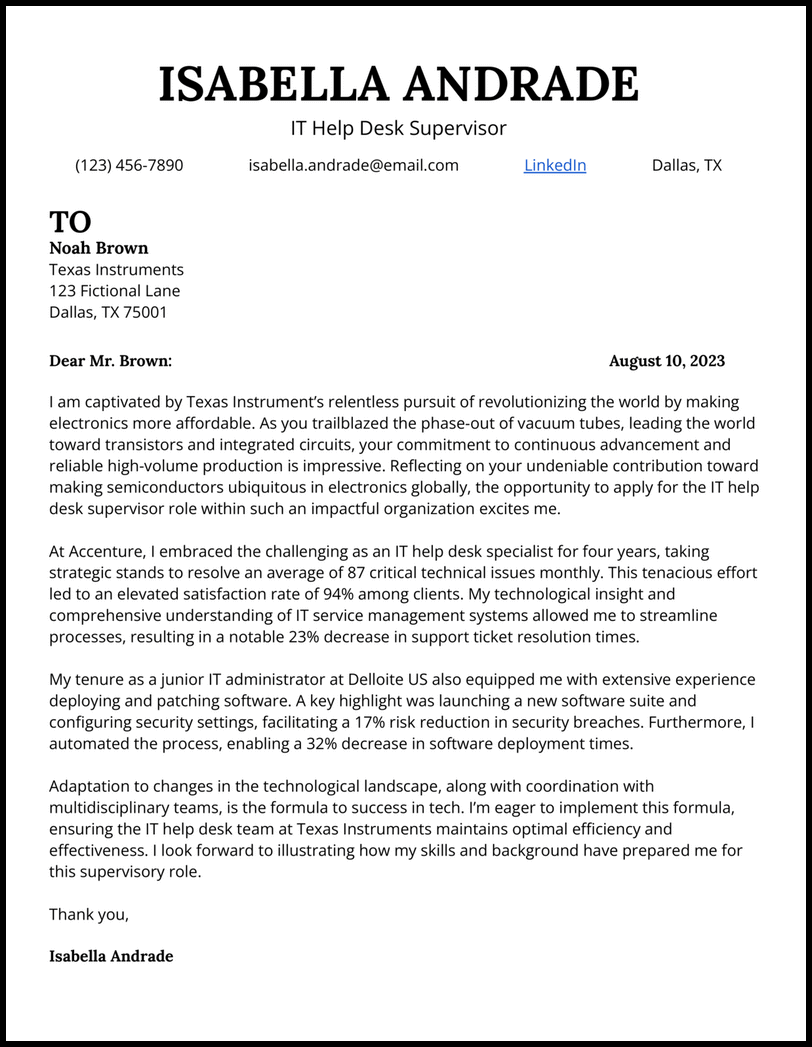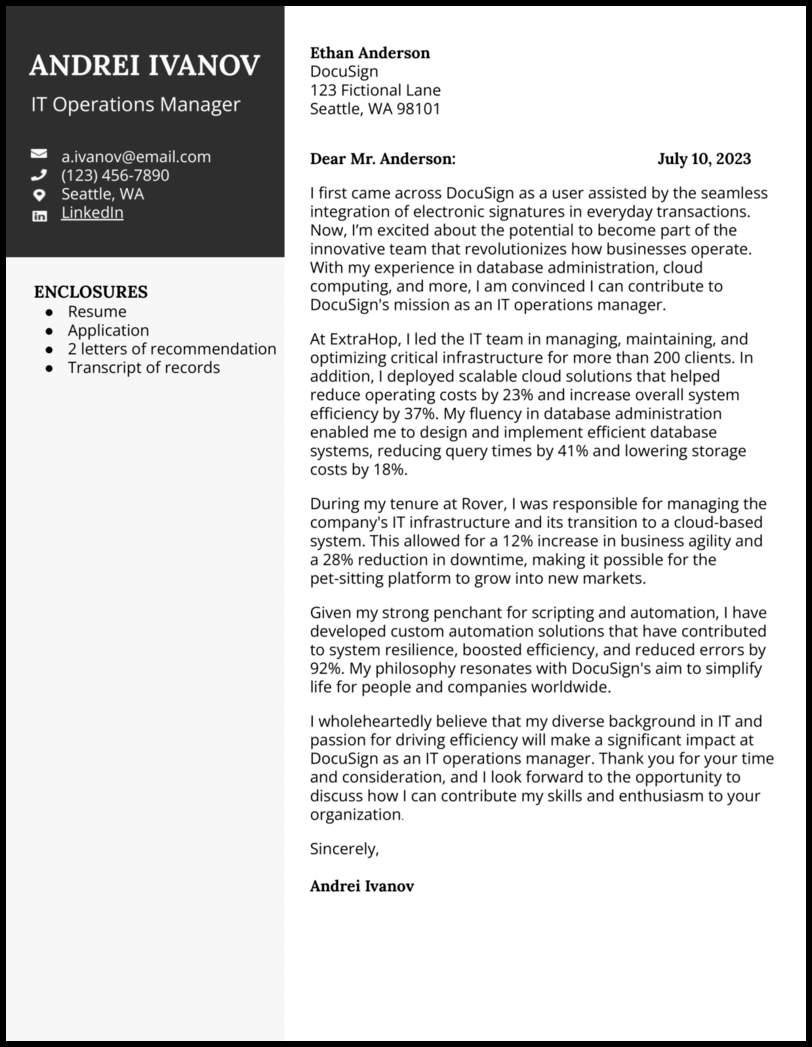






You’re the go-to computer guru with a passion and knowledge that make you a successful IT professional. Apart from an analytical mind and a deep understanding of technology, you’re also an excellent communicator capable of breaking down complex concepts for a non-technical audience.
You’ll find plenty of open positions when looking for a new job, but to turn them into firm offers, you’ll need to create a cover letter to accompany your IT resume that does a good job of describing your diverse skill set.
We’re here to help you score that job and advance your career. With our IT cover letter examples and tips, as well as our cover letter generator, you’ll wow hiring managers and be ready to ace those interviews!
Copy this text for your IT cover letter!
123 Fictional Avenue
Seattle, WA 98101
(123) 456-7890
July 10, 20XX
Ethan Anderson
DocuSign
123 Fictional Lane
Seattle, WA 98101
Dear Mr. Anderson:
I first came across DocuSign as a user assisted by the seamless integration of electronic signatures in everyday transactions. Now, I’m excited about the potential to become part of the innovative team that revolutionizes how businesses operate. With my experience in database administration, cloud computing, and more, I am convinced I can contribute to DocuSign’s mission as an IT operations manager.
At ExtraHop, I led the IT team in managing, maintaining, and optimizing critical infrastructure for more than 200 clients. In addition, I deployed scalable cloud solutions that helped reduce operating costs by 23% and increase overall system efficiency by 37%. My fluency in database administration enabled me to design and implement efficient database systems, reducing query times by 41% and lowering storage costs by 18%.
During my tenure at Rover, I was responsible for managing the company’s IT infrastructure and its transition to a cloud-based system. This allowed for a 12% increase in business agility and a 28% reduction in downtime, making it possible for the pet-sitting platform to grow into new markets.
Given my strong penchant for scripting and automation, I have developed custom automation solutions that have contributed to system resilience, boosted efficiency, and reduced errors by 92%. My philosophy resonates with DocuSign’s aim to simplify life for people and companies worldwide.
I wholeheartedly believe that my diverse background in IT and passion for driving efficiency will make a significant impact at DocuSign as an IT operations manager. Thank you for your time and consideration, and I look forward to the opportunity to discuss how I can contribute my skills and enthusiasm to your organization.
Sincerely,
Andrei Ivanov
Enclosures:
Resume
Application
2 letters of recommendation
Transcript of records
Why this cover letter works
- Recognizing how the potential company influenced your career path and how their mission aligns with your philosophy is an excellent way to add a “wow” factor to your IT cover letter.
- But beyond that, the recruiter wants to see your ability to get the company desired results. Don’t just highlight your previous wins; quantify them.
Level up your
cover letter game
Relax! We’ll do the heavy lifting to write your cover letter in seconds.
Copy this text for your IT internship cover letter!
123 Fictional Avenue
Miami, FL 33101
(123) 456-7890
February 24, 20XX
Logan Gonzalez
SUNPAY
123 Fictional Lane
Miami, FL 33101
Dear Mr. Gonzalez:
My fascination with technology began in high school during a project on computer systems. The seamless integration of software and hardware captivated me, sparking a desire to delve deeper. Fast-forward to today, and I’m eager to use my technical skills, academic knowledge, and hands-on experience as an IT intern to support innovative projects at SUNPAY.
At 4Geeks Academy, I dedicated over 441 hours to mastering full-stack web development. This intensive program equipped me with proficiency in HTML, CSS, JavaScript, and React, enabling me to build dynamic and responsive web applications. A highlight project was a task management app that improved workflow efficiency and user productivity.
During my computer science coursework, I developed strong proficiency in SQL and Python, particularly in database management and data analytics. For instance, I designed a relational database for over 16K financial transactions, improving query efficiency by 18%.
In addition, I excel in adaptability and teamwork, often utilizing tools such as GitHub and Slack for effective communication and streamlined development in group projects. My participation in six major collaborations, for example, enhanced efficiency, achieving project completions 11% quicker than initially expected.
Equipped with robust analytical skills, a capacity for adaptability, and a proactive stance, I’m confident in my potential to make a meaningful impact on SunPay’s IT team. Many thanks for your time and consideration; I’m excited about the opportunity to discuss how these skills align with the IT Intern role.
Sincerely,
Samuel Osei
Enclosures:
Resume
Application form
2 letters of recommendation
Why this cover letter works
- What will it take to write a mind-blowing IT internship cover letter to land you that crucial stepping stone for your career? Highlight relevant coursework; it’s tangible evidence that you’ve got practical experience and commitment to rising through the tech industry ranks.
- For example, Logan shines the spotlight on his computer science coursework, showing off how it sharpened his SQL and Python mastery. But he doesn’t stop there; he mentions that college project that saw him design a relational database for 16K financial transactions and soar query efficiency by 18%, showing that knocking it out of the park is his thing, even as a collegian.
Copy this text for your IT administrator cover letter!
123 Fictional Avenue
San Antonio, TX 78202
(123) 456-7890
February 24, 20XX
Gabriel Carter
Rackspace Technology
123 Fictional Lane
San Antonio, TX 78202
Dear Mr. Carter:
Rackspace Technology’s cloud solutions and infrastructure optimization approach resonates with my technical expertise and problem-solving mindset. I see IT administration not as routine but as a chance to create efficient systems that let businesses thrive. My experience in managing complex IT environments and solving various technical issues positions me to assist clients in navigating technical challenges and staying competitive.
At Bridgehead IT, I led a team that cut new tool onboarding time by 26% by streamlining business technology processes. Also, managing SaaS applications, overseeing project lifecycles, and applying agile methodologies allowed me to support over 124 users across departments.
At USAA, I improved operational efficiency and aligned IT infrastructure with financial security standards. Using Ansible automation to streamline security patching across 508 servers, I cut out manual updates, saving $32,084 per year in labor.
Troubleshooting complex technical challenges and implementing security best practices at Silotech Group have reinforced my expertise in system administration. Proficiency in networks, servers, and APIs, along with Python and Jira, has allowed me to drive solutions that improve system reliability and security.
Delivering IT solutions focusing on security and efficiency resonates with your mission, and I would appreciate a chance to discuss how my background can contribute to your initiatives. Thank you.
Sincerely,
Sara Ivanova
Enclosures:
Resume
Application form
2 letters of recommendation
Why this cover letter works
- There are a few things that hiring managers hate more than email addresses like “[email protected],” and a generic IT administrator cover letter is at the top of that list. Our point? Unless you want to get under their skin and torpedo your job chances, make sure to tailor your piece to the open role.
- Take your sweet time going through the job posting, pointing out the skills (both soft and technical) and experiences the potential employer is hunting for. Whether it’s the ability to manage SaaS applications or put software like Ansible, Jira, and Python to good use, your cover letter must show you’re up to scratch.
Copy this text for your IT support cover letter!
123 Fictional Avenue
Los Angeles, CA 90001
(123) 456-7890
August 10, 20XX
Victoria Sanchez
Netflix
123 Fictional Lane
Los Angeles, CA 90001
Dear Ms. Sanchez,
As a longtime Netflix consumer, I’m excited to contribute to its technological heartbeat as your next IT support assistant. Having been captivated by numerous series and films from the comfort of my living room, I have great respect for the hard-working teams behind the screens. With my proficiency accrued from various IT roles, I’m eager to support the teams that have been impressing me, and millions, for years.
In my previous role at Laserfiche, I enhanced the efficiency of their IT network by providing remote desktop support. This led to a substantial cut in system downtime by 18%. Additionally, my hands-on hardware repair skills ensured a quick turnaround of two hours for any major breakdown, leading to minimum disruption in productivity.
I further solidified my skill set in network administration during my tenure at Age of Learning. In two years, I significantly improved the company’s network efficiency by implementing several optimization techniques, resulting in a 22% reduction in bandwidth utilization. This also led to a 9 percent decrease in costs associated with network maintenance.
By marrying my expertise in IT support and a deep understanding of the unique needs of the streaming industry, I am certain of my ability to contribute positively to Netflix. My drive to facilitate smooth and efficient digital operations aligns with Netflix’s user-centric approach. I greatly appreciate your time and consideration and look forward to discussing my application with you further.
Sincerely,
Ayumi Sato
Why this cover letter works
- Expertise in computer systems and networks, repairing and installing peripherals, and excellent communication and interpersonal skills are key to excelling in the IT support role.
- While you strive to show these skills in action in your IT support cover letter, take it further by connecting your past work to the current needs of the hiring organization.
Copy this text for your IT help desk cover letter!
123 Fictional Avenue
Dallas, TX 75001
(123) 456-7890
August 10, 20XX
Noah Brown
Texas Instruments
123 Fictional Lane
Dallas, TX 75001
Dear Mr. Brown:
I am captivated by Texas Instrument’s relentless pursuit of revolutionizing the world by making electronics more affordable. As you trailblazed the phase-out of vacuum tubes, leading the world toward transistors and integrated circuits, your commitment to continuous advancement and reliable high-volume production is impressive. Reflecting on your undeniable contribution toward making semiconductors ubiquitous in electronics globally, the opportunity to apply for the IT help desk supervisor role within such an impactful organization excites me.
At Accenture, I embraced the challenges as an IT help desk specialist for four years, taking strategic stands to resolve an average of 87 critical technical issues monthly. This tenacious effort led to an elevated satisfaction rate of 94% among clients. My technological insight and comprehensive understanding of IT service management systems allowed me to streamline processes, resulting in a notable 23% decrease in support ticket resolution times.
My tenure as a junior IT administrator at Deloitte US also equipped me with extensive experience in deploying and patching software. A key highlight was launching a new software suite and configuring security settings, facilitating a 17% risk reduction in security breaches. Furthermore, I automated the process, enabling a 32% decrease in software deployment times.
Adaptation to changes in the technological landscape, along with coordination with multidisciplinary teams, is the formula to success in tech. I’m eager to implement this formula, ensuring the IT help desk team at Texas Instruments maintains optimal efficiency and effectiveness. I look forward to illustrating how my skills and background have prepared me for this supervisory role.
Thank you,
Isabella Andrade
Why this cover letter works
- A successful IT help desk cover letter emphasizes problem-solving skills, technical proficiency, customer service, teamwork, adaptability, and attention to detail.
- Don’t get carried away with singing your wins, though. Use a few sentences to show you did your homework on the company.
Copy this text for your IT technician cover letter!
123 Fictional Avenue
Kansas City, MO 64101
(123) 456-7890
November 10, 20XX
Alexander Harris
Black & Veatch
123 Fictional Lane
Kansas City, MO 64101
Dear Mr. Harris:
My passion for transforming technology challenges into efficient solutions aligns with Black & Veatch’s vision of innovation and excellence in the engineering and construction sectors. As a self-learned professional, I am excited to apply for your vacant IT technician role.
At my most recent IT job at L3Harris Technologies, I drafted detailed troubleshooting documentation for 13 wireless equipment. Using Wireshark, I constantly monitored the firm’s networks and introduced endpoint security, preventing 9 data breaches. Thanks to these contributions, I was also chosen to be part of a $1.6M+ project where I helped multiple clients with their daily IT needs.
While working for Leidos, I leveraged VMware to design a password reset system on Linux and Windows, reducing monthly support tickets by 29%. Additionally, I maintained a record-low troubleshooting time of 53 minutes or less for fixing daily bugs.
During my very first stint as an IT support at Mid-Continent Public Library, I resolved an average of 12 tickets every day on Zoho Desk and updated the library book management software to increase security. Here, I learned and polished my skills in assisting team members with tech-based problems.
I am ready to take on new challenges at Black & Veatch and support the development of top-notch engineering solutions. I look forward to contributing to your IT initiatives and supporting your mission of delivering critical infrastructure solutions to businesses worldwide.
Sincerely,
Marco Hernandez
Enclosures:
Resume
Application
Academic transcript
Why this cover letter works
- If you don’t have the world’s best achievements, outline your career growth to show how you’ve honed your technical process over the years.
- Check out Marco’s IT technician cover letter and note how his experiences have led him to go from resolving IT tickets for team members to leveraging endpoint security to prevent data breaches. Use similar impacts to show you’re not just here to fix problems but to grow with them, one upgrade at a time.
Copy this text for your IT specialist cover letter!
123 Fictional Avenue
Buffalo, NY 14202
(123) 456-7890
November 10, 20XX
Daniel Thompson
Synacor
123 Fictional Lane
Buffalo, NY 14202
Dear Mr. Thompson,
When I first saw the opening for an IT specialist at Synacor, I knew I had to apply. My Computer Science degree from Carnegie Mellon University and five years of IT experience match all the requirements you’ve listed in the job description. My expertise in various software also positions me to optimize the company’s network and improve its cybersecurity measures.
During a recent stint at GlobalTech Solutions, I led the implementation of a network monitoring system using Zabbix, reducing monthly network downtime by 16%. Designing secure infrastructures with Cisco ASA firewalls further resulted in a 22% decrease in annual security incidents—a crucial skill needed at Synacor.
As a help desk technician at ByteTech Solutions, resolving network connectivity issues was at the forefront of my work. With expertise in VMware vSphere, I oversaw four modern applications and ensured timely updates for the latest Kubernetes releases. My contribution to improving network performance and running various apps under one roof helped the company save $13,582 in potential IT maintenance costs.
I developed a strong proficiency in Microsoft Azure and network protocol analysis when interning for EmergenceTek Group. Handling various tasks like assisting senior technicians to resolve tickets and interpreting data packets over multiple networks, I enabled the IT to complete their weekly tasks 2 hours quicker on average.
My career in the IT industry has helped me develop all the skills needed for your company’s IT specialist role. I am confident that my addition to your team will drive technological growth and help Synacor design innovative solutions for users worldwide. Thank you for considering my application.
Sincerely,
Sophia Kim
Enclosures:
Resume
Application form
2 letters of recommendation
Why this cover letter works
- One sure-shot way of getting hired (one that never goes out of style) is clearly stating how your profile checks all the boxes of the job description.
- From your education qualifications and technical know-how to experience, give employers all the reasons to continue reading your IT specialist cover letter. Next, use quantified metrics to seal the deal and make them think, “This candidate doesn’t just meet requirements; they’re the IT person we needed all along!”
Related cover letter examples
How to Write an Impressive IT Cover Letter

Working in IT has helped you develop your natural keen eye for detail and no-nonsense approach, so you’re all set to begin crafting the perfect cover letter. The key is to be concise and specific, all the while still being ready to describe your greatest accomplishments in a way that gets you the job.
Which accomplishments would that be? Let the job description be your guide. Read it carefully and adjust your cover letter to match not just the tone, but also the skills and achievements required.
Don’t forget to personalize your cover letter to the job and express that this particular job is the one that you want, and not just any job in IT.

Write a captivating greeting and intro
To instantly show that you’ve done your homework, make sure to address the hiring manager by name if at all possible. Next, discuss why you want to apply your extensive skills in things like network management, database administration, or customer service to succeed in this role.
It’s a good idea to also try to get a little personal. Perhaps the company has helped local schools set up their new computer rooms? If so, make sure to mention how much your own values align with the company’s mission to help out the community.
If you’re not sure how to start, here’s an example of what not to do. Use the opener to discuss how you can help the company, not how it can help you.
This is a no-go!
I’m applying for this position because I saw your ad on Indeed. I like computers and want to work in IT so please consider me for this job.
Now, this opener does a much better job of showing why the applicant is excited to lend their skills to that particular job. You can do the same by dropping a line that connects your skills in IT to the company’s overarching mission and background.
This one is a winner!
As a longtime Netflix consumer, I’m excited to contribute to its technological heartbeat as your next IT support assistant. Having been captivated by numerous series and films from the comfort of my living room, I have great respect for the hard-working teams behind the screens. With my proficiency accrued from various IT roles, I’m eager to support the teams that have been impressing me, and millions, for years.

Show off your expertise in the body of your cover letter
The body paragraphs of your cover letter are the meaty parts that really cement why you’re the IT expert that particular company wants to hire. You should limit this section to a maximum of three paragraphs, so be concise, but effective as you mention some of your career highlights.
The exact content of this section will depend on your role. If you’ve worked as an IT help desk support worker, dive into how your in-depth knowledge of technology helped end users overcome various issues. However, if your job was more on the operations side, you might want to talk about successful IT projects you’ve run or participated in.
Don’t just list off things you did, though. Instead, use relevant metrics to explain the impact your work has had. You’ve already covered some of them in your IT resume—your cover letter lets you go into more detail.
This is impressive!
My tenure as a junior IT administrator at Delloite US also equipped me with extensive experience deploying and patching software. A key highlight was launching a new software suite and configuring security settings, facilitating a 17% risk reduction in security breaches. Furthermore, I automated the process, enabling a 32% decrease in software deployment times.

Wrap up your cover letter in a memorable way
To end on a strong note, lean into your in-depth knowledge of IT and how it can help that particular company. For instance, if you’re applying for a job in cybersecurity, discuss how your expertise in preventing DDoS attacks can help the business strengthen its position as a market leader in secure networking.
In addition, express your excitement at joining the ranks of that particular business. Now is also a good time to thank the reader for their consideration.
The below closing paragraph is a good example of what you should avoid doing. It’s not very memorable and it doesn’t paint the candidate as an IT expert; instead, it gives off the impression that they just want any job, not that job.
Don’t do this!
I know I don’t have much experience but I will work hard. I really want to work for you and I can start any time because I need a job right away.
The below example takes a much more positive spin on things. The candidate expresses how their background can make a difference, and they refer to the company by name, which gives instant brownie points in a cover letter.
Let’s go!
I wholeheartedly believe that my diverse background in IT and passion for driving efficiency will make a significant impact at DocuSign as an IT operations manager. Thank you for your time and consideration, and I look forward to the opportunity to discuss how I can contribute my skills and enthusiasm to your organization.







